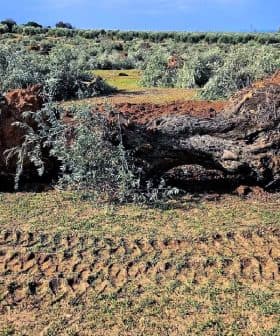Hundreds of Native Olive Trees Burned in Balochistan Wildfires
Extensive wildfires in the Koh-e-Sulaiman mountain range in Balochistan have caused significant damage, burning a large portion of the world’s largest chilgozha pine nut forest. The blaze, fueled by a prolonged drought and record heatwave, has destroyed olive trees and is expected to have long-lasting economic impacts on the region.
Pakistani officials struggle to estimate the full extent of the damage caused by extensive wildfires, which burned hundreds of thousands of trees in the Koh-e-Sulaiman mountain range in the western Balochistan region.
The blaze has ravaged what many consider the largest chilgozha pine nut forest in the world. Local sources believe that at least 40 percent of that forest was burned down.
With it, many olive trees were also destroyed by the flames. The local sources added that the economic downturn caused by the devastation will be felt for generations.
See Also:Extreme Weather Events Are Getting Worse, Affecting Food Availability, Report FindsLocal experts interviewed by TheDawn magazine warned that the prolonged drought combined with a record heatwave triggered the massive blaze.
Kamran Hussain, a World Wildlife Fund researcher, said the fire season in Pakistan started earlier than usual because of climate change.
“The scorching heat sucks all water from the vegetation leaving it dry and increasing the chances of fires,” he said.
The Pakistani government confirmed that three people were killed while trying to stop the flames.
The wildfire spread from neighboring woods to Koh-e-Sulaiman, a national park at a high altitude that is considered a unique environment for many flora and fauna species. There, the flames were fueled by the strong winds.
Local experts believe that the devastation caused by the fire will severely impact the livelihoods of the area’s residents, many of whom are involved in forestry-related activities. The Shirani forest extends for about 260 square kilometers and represents a large portion of Balochistan forest, covering about 1.4 percent of the region.
Media reports also indicated that as many as 800 olive trees were destroyed by the wildfires in the historic Musakhail forest, which has been home to olive trees for 500 years.
The Pakistani government identified the region for the expansion of the country’s olive groves due to the appropriate climate, and economic opportunities olive cultivation is expected to bring to the area.
Muhammad Yahya, the provincial coordinator of the Food and Agriculture Organization of the United Nations, told TheDawn that what happened in the park could be far from over.
“There are still trees that are burning, and sparks of fire are still erupting from them,” he said. “The trees are throwing off their flames, putting the other vegetation at risk. And this increases the threat of another fire breaking out in the forest if not contained in time.”
The wildfire that affected Balochistan is a significant event in a country where fires routinely burn during the dry season. Firefighters recently managed to control a wildfire in a swath of forests in northern Pakistan, near the country’s capital, Islamabad.
Other wildfires have been reported in recent weeks in the mountains of the Swat district, just north of the capital. According to AryNews, a local media outlet, this wildfire took more than a week to be curtailed, and four people died.
The Global Forest Watch international observatory estimates that from 2001 to 2021, Pakistan lost 9,750 hectares of tree cover, equivalent to a 1 percent decrease since 2000.
“Pakistan is already a forest-poor country as only 4.8 percent of its land is covered with forests,” TheNews, another local media outlet, wrote in an editorial.
“The global average is 31 percent. Even South Asian countries like India, Bangladesh and Sri Lanka have 24 percent, 14 percent and 34 percent of their land mass covered with forests and plants,” they added.









